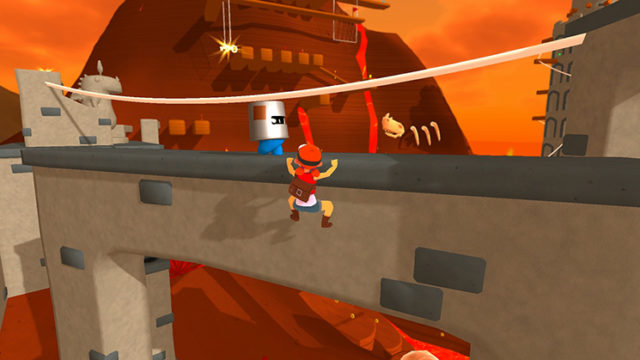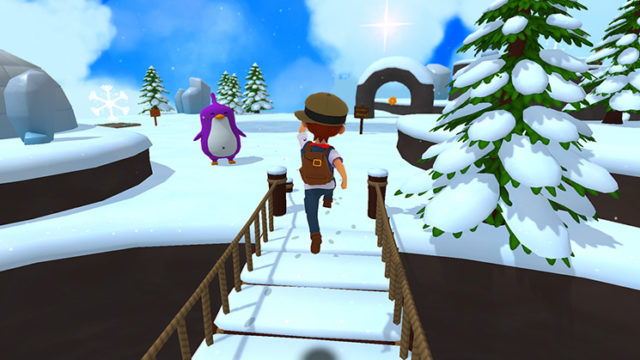Tried and true mechanics and structure; good variety of objectives and side activities; good art direction and some pretty levels; fantastic soundtrack.
Just about everything could use one more layer of polish; sticks a little too close to the Mario 64 formula; light on content for anyone that isn't a 100% completionist.
For years, it seemed as though many a gamer was lamenting the death of the 3D platformer as a genre. Yes, the genre’s mechanics appeared regularly in many different types of games, but platforming for the sake of collecting many trinkets and doodads appeared to be a thing of the past. Thankfully, the indie boom has caught up with this demand as many talented developers have drawn inspiration from the likes of Mario 64 and Banjo-Kazooie to create new takes on the genre, like Yooka-Laylee and Snake Pass. PolyKid is one such indie studio throwing their hat in the ring for this revived genre, and it goes by the name of Poi.
Like many of the genre’s greats, Poi features a very simple story. You play as either the boy or girl in a pair of siblings who have set out seeking adventure when they come across an old man in need of help. This man is an experienced adventurer who is seeking a famous treasure, but first must recover his Explorer Medallions which were lost in a recent storm. Naturally, the kids hop aboard the old man’s airship and set out on a grand journey.
This airship ultimately serves as a hub world of sorts with the game’s levels silhouetted on the horizon. You can either point the ship towards one of the levels to select it, or explore the ship and the surrounding airspace. On the ship, you can use coins collected throughout your adventure to buy helpful gear from the old man, change into new outfits found hidden in the world, or swap between playing as the boy and girl. The surrounding airspace grows more and more crowded with floating islands and other ships as you progress and they offer additional challenges and mini levels to complete for additional Medallions. The mechanic for traveling between these hovering locales is actually quite fun, as you leap into the air and deploy a parachute that allows you to freely soar from place to place; this is one of the best parts of the game but is tragically underutilized as it only can be used here and in a specific set of challenge levels.

When you head to the main levels, you will discover a gameplay flow very familiar to anyone who has played Mario 64. Each area is relatively large with a number of Medallions that can be earned through platforming, puzzle solving, item collecting, or combat challenges; even though you are directed through a particular order of earning them, some Medallions can be acquired out of sequence. Each level is also filled with additional collectibles, including fossils and Golden Gears, that can be brought back to the hub world for yet more Medallions. Once enough Medallions are collected, you open up the next level, though you are of course free to continue exploring previously unlocked areas or participating in the hub’s side activities.
Like the game’s structure, Poi’s mechanics will feel incredibly familiar as they too feel like they were lifted from Mario 64. From gaining extra height on your third jump to being able to do a diving roll maneuver, Mario’s move set is very close to being represented in its entirety. Thankfully, this isn’t necessarily a bad thing, because these mechanics work almost as well in Poi as they did back in 1996. As a result, you’ll likely pick up on what to do very quickly. If you see a platform you need to get to, you know you’ll probably be jumping to it, and if you see a baddie you’ll know to jump on it. The only major difference is in the boss battles, but they are few in number and still quite simple to figure out.
While Poi obviously exists as a love letter to Mario 64, it can’t quite live up to it due to a general lack of polish. Almost everything about Poi works fairly well, but there are so many bits and pieces that just feel like they could have used a little bit more work. Several enemies seem to feature attack animations with strange hit boxes that lead to cheap hits and too many platforms are ringed with edges just steep enough to send you sliding into oblivion for no apparent reason. These issues are relatively small, but you’ll encounter them just frequently enough for them to be noticeable and annoying.

This lack of polish continues with the game’s visuals. For the most part, Poi looks rather nice; each stage features familiar motifs like deserts, lava, or ice, but they at least offer some solid aesthetic variety. The design is made even better by how each stage can be presented in a number of different ways based on time of day and weather conditions, leading to some nice effects and lighting. However, while the cartoony, flat shaded visuals generally look good, you will frequently encounter certain objects and places that could have definitely benefited from additional detail. This is especially true with certain character models, where the problem can be even further compounded by some rather poor animation, an issue that even rings true for some of the player character’s moves.
In terms of the amount of content on hand, Poi is a decent package assuming you are willing to do everything the game has to offer. I completed the main quest in under six hours and I imagine most people could collect everything in around ten, if not less. However, beating the game does unlock a hard mode which mirrors all the levels and reduces your health from having three hits to work with to just one. While the game as a whole is on the easy side, only having one heart will definitely make some sections challenging, so assuming you’re willing the to go the distance and beat hard mode it should at least double your time with the game.
Thankfully Poi has one area in which it is an unqualified success — its soundtrack. As frequently as Poi looks to Mario 64 for inspiration, it instead seemed to draw inspiration for its music from the scores of classic adventure movies. The main theme is memorable, the soundtrack as a whole carries a real sense of adventure to it, and everything is orchestrated in a big, bombastic way. I think the music successfully captures the feeling the rest of Poi couldn’t quite achieve.
Given all the faults I’ve listed above, it might seem like I’m being rather harsh on Poi , but it’s worth reiterating that many of these problems are relatively small and pertain mostly to areas where the game just needed a bit more polish. With a little extra time and resources, I imagine Poi could be made into a tighter, and all around better experience. That being said, it still does suffer from a general lack of creativity. Despite having its own aesthetic and musical sensibilities, Poi’s structure and mechanics are simply so close to those of Mario 64 that it’s impossible to avoid making comparisons. Also, it feels somewhat unfair to Poi that if was released in such close proximity to Mario Odyssey. However, putting it all into perspective, we are left with a perfectly decent game. Poi does nothing to move its genre forward and even though its wanting for polish in many areas, its faults are small enough that they will likely prove little more than minor annoyances for those looking to kill some time after they complete Mario’s latest.
Nintendojo was provided a copy of this game for review by a third party, though that does not affect our recommendation. For every review, Nintendojo uses a standard criteria.




 ShareThis
ShareThis





